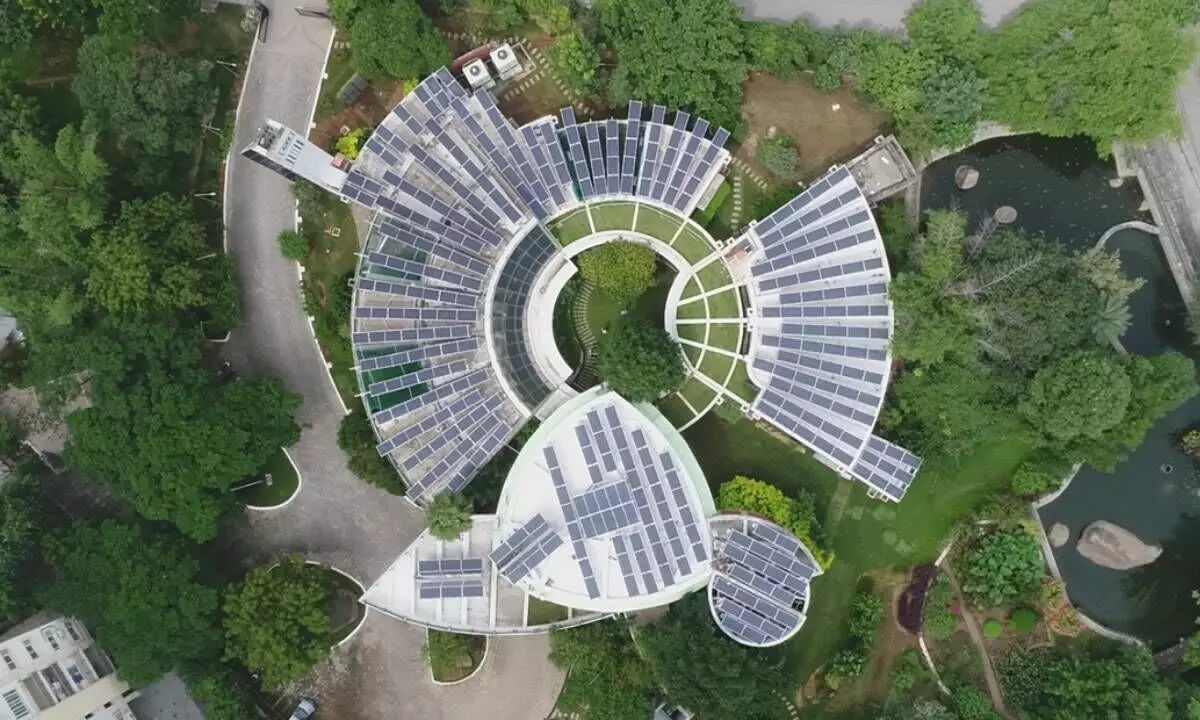1st greenest building outside US is in Hyd!
CII - Sohrabji Godrej Green Business Centre is also India’s first platinum-rated green building
image for illustrative purpose

Hyderabad Green building certification body Indian Green Building Council (IGBC) was formed in 2001 by the Confederation of Indian Industry (CII) to promote green building concepts in the country. The first step towards green building movement was taken by setting up of the IGBC headquarters the CII - Sohrabji Godrej Green Business Centre in Hyderabad in 2003.
This Net Zero Energy facility is a testament of the cordial union of traditional architecture and technology. At the time of its inauguration, this was the first greenest building outside of the US to be certified by the Leadership in Energy and Environmental Design (LEED), an environmentally oriented building certification programme run by the US.
This centre was also India’s first platinum-rated green building. It reflects ancient Indian ethos. On five acres of land stands a central courtyard filled with green and fragrant flower plants, huge water body, traditional jaali walls, and energising natural light, transcending one into a completely different space amidst the buzzing IT world (Hitec City) of Hyderabad.
The first power step towards green building initiative was taken in 2001 when the past president of CII and Chairman of Godrej Green Business Centre, Jamshyd Godrej wanted to demonstrate that the Indian construction industry can also measure up to the world standards of technology, energy and environment.
“Jamshydji wanted the IGBC HQ to be a model green building to showcase co-existence of age-old tradition and ethos of architecture as well as the modern technology. The united Andhra Pradesh government came forward to partner with IGBC for setting up of IGBC HQ, an exclusive Center of Excellence,” Deputy Executive Director of IGBC, M Anand, told Bizz Buzz.
IGBC HQ was inaugurated by the then President APJ Abdul Kalam on June 14, 2004. The architects and designers who conceptualised and executed the project were given a mandate to align futuristic technology with the Indian way of living depicted into the design and construction of the building.
“We have integrated many of the ancient architectural elements like the central courtyard that brings an enormous amount of life into IGBC HQ, in the form of natural light, air and water as rain during monsoons. The entire wall is made up of autoclaved aerated concrete blocks. This is the first building built on energy modeling principles based on Hyderabad’s temperature, rainfall among others, aligned with our ancient wisdom,” Anand further said.
This centre was recognised as India’s first platinum rated green building and world’s greenest building in November 13, 2003, after receiving the highest number of points to make a building green. In the same year, it started functioning with 17–20 people; now 100 employees work here to handhold and develop the rating programme. This city, well known for its history, food and culture is also known for the huge natural rocks that are even till date preserved as a part of living past at a five-star hotel and so is the case at IGBC HQ. “When one enters this centre, they will get to see thousands of years old natural rocks.
We have also retained the topography due to which during monsoons our building is not flooded with water. Also, the usage of high performance glass brings in ample amount of light into the building but not the heat,” Anand adds.
IGBC believes that the HQ represents the unity of five elements and is aligned with the ‘PanchaBhutas’ – Bhoomi, Gagan, Vaayu, Agni and Neer – integrated in a modern and contemporary method. The other natural element considered a part of the green building is water. The IGBC HQ saves a lot of water by using ultra low flow fixtures. India’s first waterless urinal has been present here for the last 20 years. Rain water is harvested through recharge pits with a holding capacity of five lakh litres. And, grey water with organic waste is treated here through natural process/root zone treatment method meeting pollution control board norms. Coming to go-green initiatives, the IGBC HQ is the best model. Here, the trees, plants and saplings are native to Hyderabad soil, weather and rainfall conditions. “As the IGBC HQ was constructed during the early stage of the green building movement, we have spent an 18 per cent extra on the cost of construction compared to a 20,000-sq ft sized conventional building built during that period,” Deputy Executive Director said. “However, this centre has saved more than the expenditure by reducing energy consumption by 30-40 per cent and water consumption by 45 per cent when compared to any conventional building,” he added.

